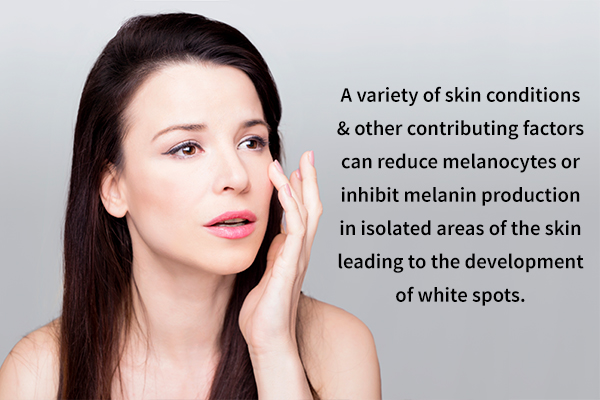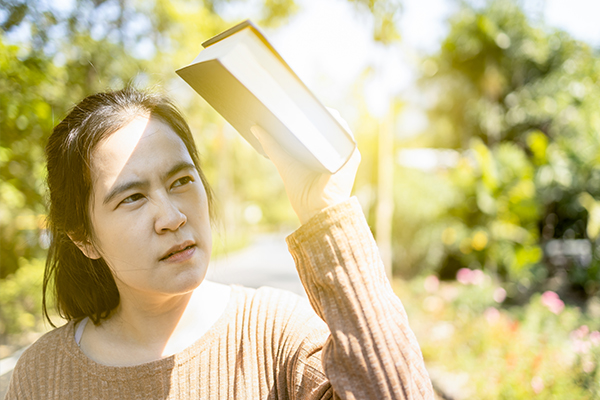In this article:
White spots on the skin are a common beauty complaint, especially among dark-skinned people. Specialized skin cells called melanocytes produce a pigment called melanin, which determines the natural skin complexion as well as the color of the eyes and hair. The higher the concentration of melanin, the darker the skin.

White spots occur when there is localized loss of melanin in specific areas of the skin. This can happen due to a decline in the number or function of melanocytes.
In other words, your skin may lose its color in specific areas where there aren’t enough melanocytes or the melanocytes don’t produce enough melanin. (1) The discoloration appears in the form of white spots or patches, and the problem usually starts in the mid-twenties.
Causes of White Spots on the Skin

A variety of skin conditions and other contributing factors can reduce the number of melanocytes or inhibit melanin production in isolated areas of the skin, leading to the development of white spots.
Some of the major culprits behind the appearance of white spots are:
- Vitiligo, which is an auto-immune disorder (2)
- Pigmenting pityriasis alba, a rare skin condition that mostly affects children or young adults
- Eczema
- Seborrheic dermatitis
- Psoriasis
- Idiopathic guttate hypomelanosis (sunspots)
- Post-inflammatory hypopigmentation (3)
- Reaction to chemicals
- Milia
- Fungal infections such as tinea versicolor
- Nutritional deficiencies
- Anemia
- Psychological stress
- Side effect of certain medications, particularly antibiotics
- Exposure to allergens
Signs and Symptoms Associated With White Spots
White spots can develop anywhere on the body, but they usually appear on exposed areas of the skin, which face the most sun damage. This includes all those body parts that remain uncovered by clothes or shoes, such as the face, neck, back of the hands, forearms, and shoulders.
Moreover, white spots are also common in areas where the skin forms folds, such as the elbows. White spots can be the result of a variety of underlying skin conditions that may present the following symptoms along with the sporadic skin depigmentation:
- Skin dryness
- Itchy skin or pruritus
- Skin inflammation
- Gray hair
- Pale or discolored lips
- Blisters
- Red scalp
Medical Treatment for White Spots

White spots are the result of reduced melanocytes or melanin in specific areas of the skin, but there is still no clarity as to why this happens.
In most cases, the discoloration is purely a cosmetic problem rather than a health concern. You can easily go without treatment if the condition doesn’t bother you.
But treatment becomes a necessity if the spots increase in size and number to cover large areas of the body. Prominent white patches all over your skin can greatly hamper your appearance and make you self-conscious.
Currently, only a few treatment modalities are available to reduce the occurrence and visibility of white spots. Your doctor can help you make the best choice after assessing your skin condition.
Here are some of the commonly recommended interventions for treating white spots: (4)
- Low-dose corticosteroid creams – These topical steroids can help restore some color to the pale white patches and are hence used in the early stages of the disease. They work by curbing skin inflammation, often reducing the number of melanocytes in the affected area and making it lighter than the surrounding skin.
- Medications such as psoralen, latanoprost, and afamelanotide.
- Various types of light therapy, such as UVA light therapy, photochemotherapy, psoralen-UVA (PUVA), and narrow-band UVB (NB-UVB) therapy.
- Monochromatic excimer light (MEL) laser therapy.
- Skin grafting – Healthy pigmented skin from some other part of your body is harvested and surgically inserted over the discolored patches.
- Skin tattooing – This involves inserting ink that matches your skin color to camouflage the white patches.
- Melanocyte transplant – This is an experimental procedure that is still under research. It involves extracting well-functioning melanocytes from normal skin and using them to grow new melanocytes in the lab. These artificially manufactured melanocytes can then be transplanted back into the discolored skin to increase melanin production in the area. (5)
- Antifungal creams, shampoos, and skin products – These products are prescribed to treat spots caused by an underlying fungal infection. If your condition does not improve after topical treatment, the doctor may put you on a short course of antifungal pills.
Note: Many of the above-mentioned treatments are recommended only when the white spots stop spreading or growing bigger. Your condition must remain stable for at least a year before you can initiate treatment. Moreover, invasive surgical procedures are only meant to treat severe forms of the disease in adults.
Diagnosing the Cause of White Spots

White spots can be symptomatic of a wide range of underlying conditions that have to be addressed in different ways. Thus, you need to understand the root cause of your discoloration before treating it.
One of the most common causes of white spots is vitiligo. This autoimmune disorder is associated with a very specific form of discoloration that can easily be identified by a trained dermatologist simply by looking at it. However, the light-colored patches may not be as apparent on fairer skin as they are on darker skin tones.
In cases when the spots are too faint to be seen by the naked eye, the doctor uses a special tool called a Wood’s lamp to examine the skin. This lamp shines an ultraviolet light on the affected skin in a dark room to illuminate the damaged and discolored patches.
If the visual examination is not enough to pin the culprit of your white spots, the doctor may order a few additional tests to reach a conclusive diagnosis. These include:
- Blood tests to rule out thyroid and diabetes
- Blood tests to detect any possible immune response triggered by an allergy
- Skin biopsy to eliminate the risk of cancer
Risk Factors Associated With White Spots
The following are some risk factors that may predispose you to white spots:
- Darker skin (6)
- Thyroid problems (7)
- Diabetes (8)
- Not getting enough calcium, vitamin E, and vitamin D
- Smoking
- Excessive alcohol intake
- Bug bites
- Skin scrapes
- Stress
- Genetics
- Preexisting autoimmune disorders
- Melanoma, which is a common type of skin cancer
- Non-Hodgkin’s lymphoma, a cancer of the lymphatic system
Complications of Untreated White Spots

Untreated white spots can lead to the following complications:
- Sensitivity to the sun
- Inflammation of the iris
- Uveitis, or inflammation of the middle layers of the eye
- Partial loss of hearing
- Self-image issues: anxiety and emotional distress regarding your appearance, which further aggravates the problem and may discourage you from social interaction
When to See a Doctor
White spots are mostly benign but may require medical attention if they:
- Have a sudden onset
- Grow in size and number
- Change their color or texture
- Are accompanied by pain, itching, or other discomforting or unusual symptoms
- Become a source of stress
- Don’t respond to initial treatment or recur after treatment
Final Word
White spots develop because of a fall in either the population of the melanin-producing cells or the melanin pigment itself, which can be due to a number of possible causes.
These blemishes are largely harmless but can make your complexion uneven and patchy. They stand out more starkly against darker skin and are therefore a more pressing concern among people with deeper skin tones, such as Africans-Americans.
If you only have a few small spots that don’t grow in size or spread to other areas, there is no need for medical treatment. In some cases, the spots may resolve on their own. But if the discoloration is quite prominent or generally distressing, you can seek elective treatment to even out your skin tone.

- Was this article helpful?
- YES, THANKS!NOT REALLY


